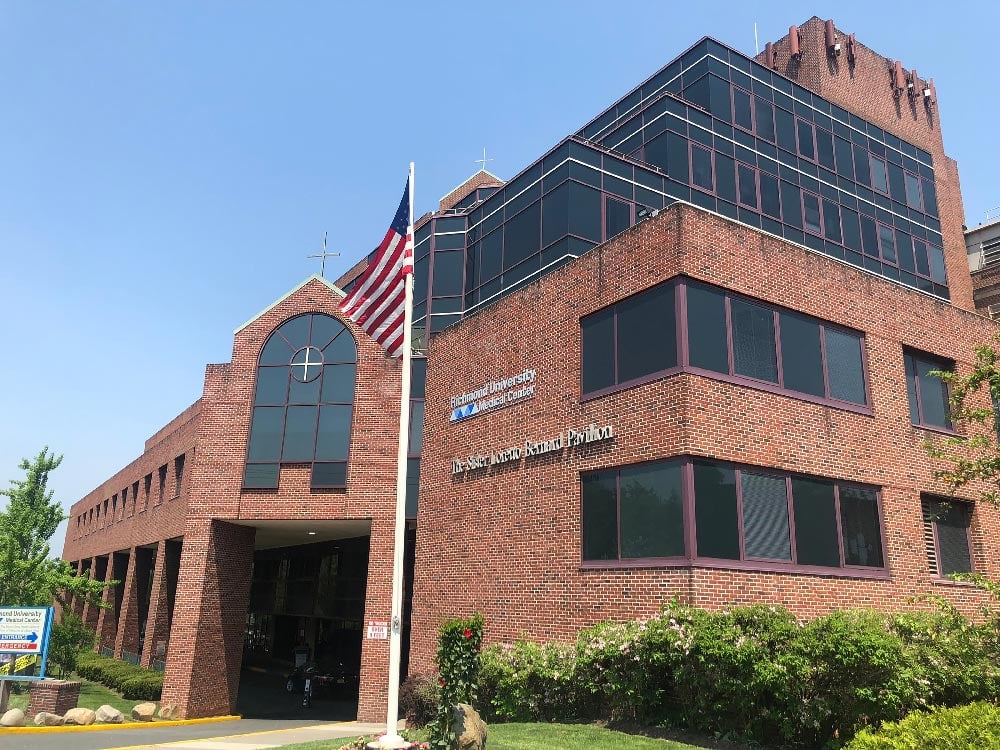The Joint Commission and American Stroke Association certifies RUMC for its expertise in performing thrombectomies for stoke victims
Richmond University Medical Center has achieved certification from both the American Stroke Association and The Joint Commission for its expertise and high-quality care performing thrombectomies for patients who have suffered a stroke. Their certification officially designates RUMC as an Advanced Thrombectomy Capable Stroke Center.
A thrombectomy is a minimally invasive procedure where a hair-thin catheter is inserted into a stroke victim to remove a blood clot from a vein or artery, restoring normal blood flow. The catheter is inserted through a small puncture site, usually in the neck, groin, or arm, and then navigated using X-ray imagery inside the vein or artery to the site of the clot. Once there, the catheter is equipped with devices that can grasp and remove the clot. The faster the procedure is performed, the better the chances of reducing disability, organ damage, and death.
“We are delighted that we have been awarded this designation. This designation demonstrates our neurointerventional team’s commitment to providing the highest level of thrombectomy care available in coordination with our emergency department, neurology team, and critical care services,” RUMC’s Chief Medical Officer, Philip Otterbeck, MD, said. “In large vessel occlusions, or LVOs, patients have blockages in the major arteries of the brain and require prompt removal of these clots. In the context of a stroke, time is brain, and Richmond University Medical Center is committed to helping our stroke patients achieve the best outcomes and recovery possible.”
To achieve certification, RUMC, which has provided healthcare services on Staten Island for over 120 years, underwent a rigorous, unannounced onsite review. During the visit, a team of Joint Commission reviewers evaluated compliance with numerous related certification standards, including program management and patient care. The reviewers also conducted onsite observations and interviews. The Joint Commission standards are developed in consultation with health care experts and providers, measurement experts, and patients.
Richmond University Medical Center first launched its thrombectomy program in 2019. Even before the hospital began the thrombectomy sub-specialty program, RUMC was recognized as a leader in stroke care, earning numerous certifications and accreditations over the years from the American Heart Association, New York State Department of Health, and The Joint Commission.
RUMC President and Chief Executive Officer, Daniel J. Messina, PhD, FACHE, said “Achieving this certification for performing thrombectomies marks a significant milestone in our continuous commitment to delivering advanced stroke care. This recognition reflects the relentless dedication of our entire medical team and ensures that our patients have access to the highest standard of treatment when every minute counts.”
Founded in 1951, The Joint Commission is the nation’s oldest and largest standards-setting and accrediting body in healthcare. To earn and maintain The Gold Seal of Approval from The Joint Commission, an organization undergoes an on-site survey by a Joint Commission survey team at least every three years. In addition to this three-year hospital-wide survey, RUMC’s thrombectomy program will also undergo a separate survey every two years to ensure the highest levels of quality patient care are being maintained within the specialty program.
“Advanced Thrombectomy Capable Stroke Center certification recognizes healthcare organizations committed to striving for excellence and fostering continuous improvement in patient safety and quality of care,” said Ken Grubbs, DNP, MBA, RN, executive vice president of Accreditation and Certification Operations and chief nursing officer for The Joint Commission. “We commend Richmond University Medical Center for using The Joint Commission certification process to reduce variation in clinical processes and to strengthen its clinical program to drive safer, higher quality and more compassionate care for individuals served.”
The American Stroke Association was created in 1998 as a division of the American Heart Association and is recognized as the leader in the latest evidence-based information on stroke, post-stroke recovery, caregiver information, resources, and education for health care professionals.
“We congratulate Richmond University Medical Center for this outstanding achievement,” said Nancy Brown, chief executive officer for the American Stroke Association. “This certification reflects its commitment to providing the highest quality of care for stroke patients.”
A stroke affects the arteries leading to and within the brain. It is the No. 5 cause of death and a leading cause of disability in the United States. A stroke occurs when a blood vessel that carries oxygen and nutrients to the brain is either blocked by a clot or ruptures. When that happens, the brain cannot get the blood and oxygen it needs, causing brain cells die. According to the American Heart Association, in 2022, stroke accounted for approximately 1 of every 20 deaths in the United States. Over 165,300 deaths were due to stroke and someone in the United States suffered a stroke every 3 minutes, 11 seconds.
This new Joint Commission certification comes as RUMC prepares to welcome a new state-of-the-art facility providing world-class stroke and cardiac care. Opening in 2026, the Joan and Alan Bernikow Heart and Vascular Institute will feature biplane imaging, the latest and most sophisticated technology for interventional procedures. Biplane imaging is one of the most advanced interventional technologies available. It uses two rotating cameras, one on each side of the patient, to take simultaneous images. As the cameras move side to side and front to back, they produce highly detailed images of blood vessels, soft tissue, and blood flow in real-time. When combined on a computer screen, the two sets of images form a 3-D portrait of the area. Biplane imaging is also used to path the blood flow through vessels, which helps to find the precise location of disease or malformation. Using a small amount of injectable dye, the biplane cameras take x-rays that can be viewed in real time to detect blockages or aneurysms and plot the best course of treatment.
The project expands RUMC’s existing Catheterization Suite, which has been experiencing expediential growth over the years. The number of preoperative and holding bays will be increased from four to seven to better accommodate patient volume while improving patient flow and staff services. The existing waiting and reception area will also be refurbished and more centrally located within the suite for better flow and functionality. The Heart and Vascular Institute is named for Joan and the late Alan Bernikow, longtime Staten Island philanthropists and humanitarians. An accountant and corporate leader, Alan Bernikow served on the RUMC Board of Trustees and passed away in 2023. In addition to the generous support provided by the Bernikows, the project is also funded by the Staten Island Foundation, Swedish Home, and the New York City Capital Grants program. More than $1.8 million in federal funds for the project was also secured by U.S. Senate Democratic Leader Charles E. Schumer, and Rep. Nicole Malliotakis.
Richmond University Medical Center (RUMC), is a not-for-profit healthcare provider serving the ethnically diverse community of Staten Island and its neighbors. We provide premier-quality patient care through a full spectrum of emergent, acute, primary, behavioral health and educational services. We do this in an environment that promotes the highest satisfaction among patients, families, physicians and staff. For more information call 1-718-818-1234 or visit www.rumcsi.org. Follow us on Facebook, Instagram, LinkedIn, and Twitter.




